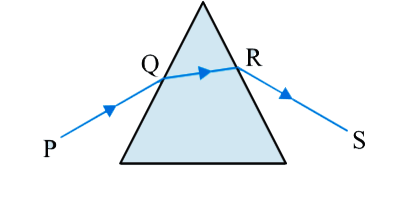Angle of minimum deviation is equal to the angle prism A of an equilateral glass prism. The angle incidence at which minimum deviation will be obtained is
60∘
30∘
45∘
sin1(2/3)
The correct Answer is:A
To solve the problem, we need to find the angle of incidence at which minimum deviation occurs for an equilateral glass prism. Here are the steps to arrive at the solution:
Step 1: Understand the condition for minimum deviation
In the case of a prism, the angle of minimum deviation (D) occurs when the angle of incidence (i) is equal to the angle of emergence (e). This means that:
i=e
Step 2: Apply the formula for deviation
The deviation (D) in a prism is given by the formula:
D=i+e−A
Where:
- D is the angle of deviation,
- i is the angle of incidence,
- e is the angle of emergence,
- A is the angle of the prism.
Step 3: Substitute the condition for minimum deviation
Since at minimum deviation i=e, we can rewrite the deviation formula as:
D=i+i−A
D=2i−A
Step 4: Set the angle of minimum deviation equal to the angle of the prism
According to the problem, the angle of minimum deviation (D) is equal to the angle of the prism (A). For an equilateral prism, the angle A is 60 degrees. Thus, we have:
D=A=60∘
Step 5: Substitute into the deviation formula
Now we can substitute D into the equation:
60∘=2i−60∘
Step 6: Solve for the angle of incidence (i)
Rearranging the equation gives:
2i=60∘+60∘
2i=120∘
i=120∘2
i=60∘
Conclusion
The angle of incidence at which minimum deviation will be obtained is:
60∘
In the case of a prism, the angle of minimum deviation (D) occurs when the angle of incidence (i) is equal to the angle of emergence (e). This means that:
The deviation (D) in a prism is given by the formula:
- D is the angle of deviation,
- i is the angle of incidence,
- e is the angle of emergence,
- A is the angle of the prism.
Since at minimum deviation i=e, we can rewrite the deviation formula as:
D=2i−A
According to the problem, the angle of minimum deviation (D) is equal to the angle of the prism (A). For an equilateral prism, the angle A is 60 degrees. Thus, we have:
Now we can substitute D into the equation:
Rearranging the equation gives:
2i=120∘
i=120∘2
i=60∘
The angle of incidence at which minimum deviation will be obtained is:
Topper's Solved these Questions
- RAY OPTICSBOOK - DC PANDEY ENGLISHCHAPTER - RAY OPTICSEXERCISE - A. Only one option is correct (JEE Advance)
73 Videos
- RAY OPTICSBOOK - DC PANDEY ENGLISHCHAPTER - RAY OPTICSEXERCISE - B. More than one option is correct
20 Videos
- PROPERTIES OF MATTERBOOK - DC PANDEY ENGLISHCHAPTER - PROPERTIES OF MATTEREXERCISE - Integer
8 Videos
- ROTATIONBOOK - DC PANDEY ENGLISHCHAPTER - ROTATIONEXERCISE - (C) Chapter Exercises
39 Videos
Similar Questions
Find the angle of minimum deviation for an equilateral prism made of a material of refractive index 1.732. What is the angle of incidence for this deviation ?
View SolutionFor a prism of refractive index 1.732, the angle of minimum deviation is equal to the angle of the prism. The angle of the prism is
View SolutionFor refraction through a small angled prism, the angle of minimum deviation
View SolutionA prism of apex angle A=60∘ has the refractive index μ=√2. The angle of incidence for minimum deviation is
View SolutionA ray of light is incident on an equilateral glass prism placed on a horizontal table. For minimum deviation which of the following is true:

View SolutionCalculate angle of minimum deviation (δm) for a regular glass prism. (Refractive index of glass = 1.6)
View SolutionCalculate angle of minimum deviation (δm) for a regular glass prism. (Refractive index of glass = 1 6)
View SolutionIf the angle of minimum deviation is of 60∘ for an equilateral prism , then the refractive index of the material of the prism is
View SolutionA ray of light passes through the equilateral prism such that angle of incidence is equal to the angle of emergence if the angle of incidence is 45∘. The angle of deviation will be
View SolutionA light ray of yellow colour is incident on an equilateral glass prism at an angle of incidence equal to 48∘ and suffers minimum deviation by an angle of 36∘. (i) What will be the angle of emergence ?
(ii) If the angle of incidence is changed to (a) 30∘
(b) 60∘, state in each case whether the angle of deviatioin will be equal to, less than or more than 36∘. ?
View Solution
